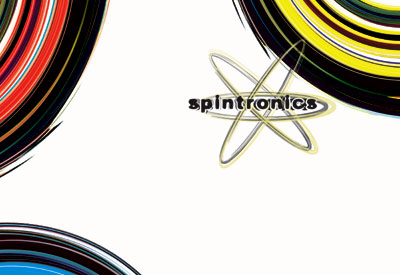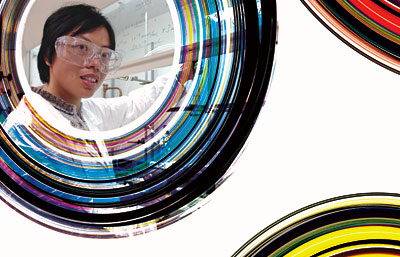
Behold the mighty electron.
One of the tiniest particles in the universe, long appreciated as an amazing carrier of electrical charge, now discovered to be even more capable..
It spins.
And that spin can be used.
Based on a concept so new many scientists don't fully understand it, spintronics has already dramatically changed the way we compute. In the next decade, it may prove the key to the quantum world where computers continue to astound.
Electrons are mites of matter that spin madly around the nucleus of an atom. In traditional electronics, electrons are used to carry an electrical charge or information from point A to point B. In spin-electronics, known as spintronics, the actual spin of the electron carries the information. When applied to computer technology -- something that is already being done -- spintronics dramatically speeds processing. Less energy is required to control an electron's spin than to push a charge through a computer's semiconductors.
Since 1998, spintronics has caused computer hard drive storage capacity to grow by leaps and bounds. And it's been the key to developing today's super-slim, super-powered laptops. But as in all new science, there's room for improvement. Scientists at North Dakota State University are employing their expertise in polymers to develop spintronic materials more flexible and less expensive to produce than the materials in use today.
NDSU assistant professor Qun "Treen" Huo and doctoral student Zoha AL-Badri are seeking two different solutions to the problem. Huo, who joined NDSU's faculty in 2001, is using supramolecular engineering (she builds extra big molecules) to create ferromagnetic thin film materials. "Ferromagnetic materials are one of the most important parts in spintronics," Huo says. A ferromagnetic material can be magnetized in a magnetic field and retain its magnetism when the field is removed..

Magnetism is key to spintronics. The angular spin of electrons makes them act like tiny bar magnets. "An electron, from a quantum physics point of view, has two spin states. It's either pointing up or pointing down," Huo says. The upward spin can be used as an "on" switch and the downward spin can be used as the "off" switch. "By controlling the electrons, on and off, you can actually build a computer..
Ferromagnetic materials are essential to building what might be called a spintronic sandwich. In the late 1990s, French scientists advanced spintronics by a giant step when they layered iron and chromium, exposed the materials to a magnetic field and watched all the iron atoms flip in the same direction. They labeled the phenomenon "giant magnetorresistance." IBM first employed giant magnetorresistance in a hard disk in 1997; hard-disk capacities have doubled every year since.
Basically, Hou and AL-Badri are trying to build more pliable, less costly "bread" for the spintronic sandwich. "Laptops are all based on inorganic semiconductor materials, which are brittle," AL-Badri says. "If you drop your laptop, it is going to break, because it's a rigid system. For that same reason, your hard drive might not withstand vibration or a power surge." Organic ferromagnetic materials will be flexible, plus they'll be cheaper to reproduce than today's silicon wafers.
The new and improved spintronic sandwich might still have metal in the middle to act as a conductor; or it might be filled with a non-conductive, insulating material; or it could be centered by a semiconductive material. Hou and AL-Badri's research is focused on creating organic ferromagnetic materials for the top and the bottom of the sandwich.
Hou has found that when she exposes her super molecules to certain solvents, the molecules assemble themselves into a single layer, with all the electrons pointing the same direction. Her research group is now conducting characterization studies on this thin film material and, Hou is happy to report, "We've had some obvious magnetic responses..
AL-Badri's research appears even more promising. "I don't want to put too much emphasis on it but ... I am very, very excited. At this stage, I'm optimistic that we are going to make a very good breakthrough in the field," he says..
The key ingredients in AL-Badri's research are polymers. "A polymer is like a big chain that connects repeated units of molecules, which act like hooks. By adding different functional groups to the hooks, you can change the physical and chemical properties of the polymer. We start with a polymer material, then we functionalize it to get the properties we want.".
If things turn out the way AL-Badri thinks they will, a patent is definitely in the future. It would be the ninth patent for AL-Badri's adviser, Philip Boudjouk. Named NDSU's vice president for creative activities and technology transfer in 2000, Boudjouk is an expert in organometallic chemistry. He's principal investigator on the NDSU spintronics project, which is being funded by a $1.75 million grant from the Defense Advanced Research Projects Agency..
Overall leadership in that agency's spintronics research is being provided by a core group of three California universities: University of California Los Angeles, UC Santa Barbara and UC Riverside (dubbed the Center for Nanoscience Innovation for Defense). NDSU and the University of Alaska Fairbanks were invited to partner in the CNID research. The test results AL-Badri is so anxiously awaiting will come from UC Santa Barbara..
Spintronics is making life in NDSU's Research and Technology Park very interesting. The technology is so prized, its potential market value is estimated at hundreds of billions of dollars a year. And then there's that priceless commodity called credibility.
"If you have a really popular research area, we call it a 'hot' area," Hou says. "If you can succeed in that type of area, then definitely people will pay attention to you. They not only watch your group, they watch the whole university."
-- C. Jelsing

































